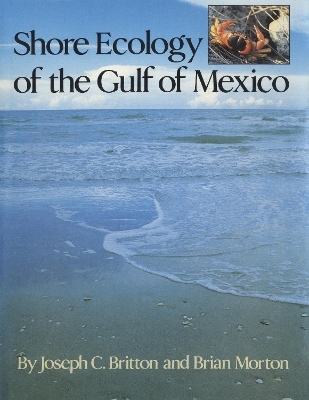
Shore Ecology of the Gulf of Mexico
University of Texas Press (Verlag)
978-0-292-77626-5 (ISBN)
- Lieferbar (Termin unbekannt)
- Versandkostenfrei innerhalb Deutschlands
- Auch auf Rechnung
- Verfügbarkeit in der Filiale vor Ort prüfen
- Artikel merken
To the casual visitor, the Gulf of Mexico shores offer mainly sun, sand, and sea. Even the standard field guides, focused on one group of animals or plants, barely hint at the wealth and diversity of habitats and species along Gulf shores. Shore Ecology of the Gulf of Mexico, using a “whole habitat” approach, breaks new ground in describing all the conspicuous vascular plants, algae, birds, mammals, mollusks, crustaceans, and other invertebrates for each marine habitat. The area covered begins west of the Mississippi delta in Louisiana and follows the shores west and south to the Yucatan Peninsula in Mexico.
Transitions between habitats also receive detailed treatment. The authors discuss changes in flora and fauna that result from differences in climate, shore geology, and patterns of precipitation in the succeeding habitats along the Gulf rim. They include discussion of more than 1,000 species of plants and animals, both on shore and in the near-shore subtidal zone, to give a virtually complete picture of western Gulf coast ecosystems. Excellent line drawings and photographs of over 800 species complement the text.
For marine scientists, students, and knowledgeable beachcombers, this is a thorough source on Gulf coast marine life.
Joseph C. Britton (1942–2006) was Professor of Biology at Texas Christian University. Brian Morton is Professor Emeritus of Marine Biology at the University of Hong Kong.
Preface
Part 1. Introduction
1. The Western Gulf of Mexico: An Introduction to Shores and Life
Taxonomy: The Names of Things
Community Relationships
Shore Categories and Gulf Shore Communities
Climate
A Survey of the Coastline
2. The Tidal Shore: Principles and Processes
Tides
Waves
Exposure Gradients
Zonation
The Molding of the Shoreline
Toward Gulf Shores
Part 2. Hard Shores
3. Hard Shores of the Northwestern Gulf
Introduction
Biotic Zonation on the Texas Jetties
Environmental Gradients and Texas Jetties
The Supralittoral Fringe
The Mid-littoral Zone
The Sublittoral Fringe and Sublittoral Zone
Gulls and Terns
4. The Hard Shores of Eastern Mexico
Introduction
Man-made Hard Shores
Natural Mainland Hard Shores
Toward the Tropical Hard Shores
A Final Perspective
5. Bay Hard Shores
Introduction
Bay Breakwaters
Pilings
The Oyster Community
Fishes
Pelicans, Cormorants and the Oyster Catcher
A Perspective on Oysters
Part 3. Soft Shores
6. Gulf Beaches and Barrier Islands
Introduction
Sands, Spits and Barrier Islands
The Foreshore: Intertidal Sand
The Strand Line
The Backshore
The Upper Shore
The Sandy Gulf Beaches of Yucatan
Sargent Beach
Toward Bayshores
7. Texas Primary Bays
Introduction
Physical Features of Texas Estuaries
Estuarine Life
Bayshore Vegetation
Fauna of the Bayshores
Biota of the Subtidal Grassbeds
Unvegetated Subtidal Bayfloors
Bay Macroplankton
Bay Fishes and Cephalopods
The Harvestfish
8. Secondary Bays, Lower Salinity Marshlands and Hypersaline Lagoons
Introduction
Salinity Profile of a Typical Estuary
Texas Secondary Bays
Coastal Marshlands
Hypersaline Lagoons
9. Mangrove Shores
Introduction
The Plants
The Texas Mangal
Mangroves of Central Mexico Shores
Northern Yucatan Mangroves
Mangroves in Perspective
Part 4. Subtidal Sands, Banks and Coral Reefs
10. Subtidal Sands and Banks
Introduction
Texas Offshore Sands
The Offshore Fauna of Yucatan
Offshore Banks of the Northwestern Gulf
11. Coral Communities of the Western Gulf of Mexico
Introduction
Reefs of the Northwestern Gulf of Mexico
Nearshore Reefs of Central Mexico
Yucatan Offshore Reefs and Banks
Toward the Caribbean
Part 5. The Future
12. The Future for Gulf Shores
Introduction
The Changing/Evolving Shore
The Human Influence
The Human Legacy
Conservation
Epilogue
Glossary
A Taxonomic Guide
Literature
Index
| Verlagsort | Austin, TX |
|---|---|
| Sprache | englisch |
| Maße | 216 x 279 mm |
| Gewicht | 454 g |
| Themenwelt | Sachbuch/Ratgeber ► Natur / Technik ► Natur / Ökologie |
| Naturwissenschaften ► Biologie ► Limnologie / Meeresbiologie | |
| ISBN-10 | 0-292-77626-8 / 0292776268 |
| ISBN-13 | 978-0-292-77626-5 / 9780292776265 |
| Zustand | Neuware |
| Haben Sie eine Frage zum Produkt? |
aus dem Bereich


